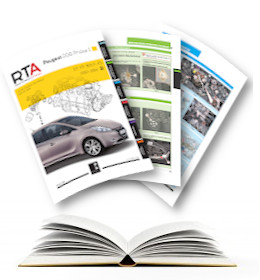Que signifie votre code Code Défaut PEUGEOT ?
Grace au système OBD, les
Peugeot
fabriqués après 1996 sont normalement équipés d'une prise diagnostique OBD.
Si l'ordinateur de la voiture rencontre un problème,un code d'erreur ou un code de diagnostic (DTC)
sera stocké dans la mémoire de l'ECU de la voiture.
Avec un lecteur OBD branché sur le port OBD (On-Board Diagnostics) de la voiture, vous pouvez lire la liste des codes stockés, et donc découvrir quel est le problème.
Les codes suivent une formule permettant de savoir généralement quel est le problème avant même de regarder le tableau ci-dessous.
Nous vous présentons ci-dessus une liste très complète des différents codes défauts possibles.
Si le code défaut de votre auto s'affiche au tableau de bord, vous n'aurez peut-être même pas besoin d'un lecteur OBD . il sera dans la liste .
Réparer le code défaut de votre auto, c'est potentiellement simple à faire avec vos revues et méthodes techniques.

Réparer le code défaut de votre auto, c’est potentiellement simple à faire avec nos revues et méthodes techniques
| Code | Libellé |
|---|---|
| P1587 | 5 Volt supply no. 1 : Voltage too high |
| P1589 | 5 Volt supply no. 2 : Voltage too low |
| P1589 | Acceleration sensor fault : Calibration incomplete |
| P1590 | 5 Volt supply no. 2 : Voltage too high |
| P1595 | 12 Volt supply no. 2 : Voltage too low |
| P1597 | Cooling circuit by-pass electrovalve |
| P1598 | Cooling circuit by-pass electrovalve |
| P1599 | Cooling circuit by-pass electrovalve |
| P15B4 | Measurement of the accelerator pedal position : Plausibility fault with Easy Move |
| P15B5 | Clutch master cylinder position measurement : Clutch information wrong saying open when driving with drive train closed |
| P15B6 | Clutch master cylinder position measurement : Clutch information wrong saying closed when changing a gear |
| P15BE | Diesel particulate filter injector control circuit/open |
| P1601 | Engine control unit supply voltage |
| P1603 | EEPROM |
| P1603 | Coolant temperature warning lamp fault : Short circuit to earth or short circuit to positive |
| P1603 | EGR control circuit range/performance |
| P1605 | Diesel pump request signal circuit/open |
| P1606 | Engine control unit control relay output circuit/open |
| P1607 | Communication on the CAN : Vehicle speed limiter error |
| P1608 | Coolant temperature warning lamp fault : Short circuit to positive or short circuit to earth or open circuit |
| P1608 | Engine control unit internal fault |
| P1609 | Engine speed sensor : Electrical fault |
| P1609 | Malfunction indicator light (MIL) driver |
| P1612 | ECU : EEPROM internal fault (Coded immobiliser) |
| P1612 | Fault internal to the engine ECU : Internal fault |
| P1613 | ECU configuration fault : Not characterised |
| P1614 | Speed limiter fault (LVV) |
| P1614 | Accelerator pedal point of resistance information |
| P1617 | ECU : Not characterised |
| P161A | Fault in communication with the piloted alternator : Absence of communication |
| P161D | Starter relay : Not characterised |
| P1621 | ECU: Software redundancy fault at the injection (Level 2) |
| P1621 | Injection ECU fault: Unspecified |
| P1622 | Correlation between inlet pressure and throttle valve position information |
| P1622 | ECU internal fault : Not characterised |
| P1623 | ECU : Fault on the fuel circuit (Level 2) |
| P1623 | ECU fault : Software redundancy error |
| P1624 | ECU : Fault on the injection time (Level 2) |
| P1624 | Incorrect ESP demand |
| P1625 | CAN communication : ESP request incoherent |
| P1625 | ECU : Software redundancy fault. Calculation error detected |
| P1626 | ECU internal fault : Not characterised |
| P1628 | Incoherent information from the brake switch or accelerator pedal sensor : Safety |
| P162A | ECU : Malfunction internal to the vehicle cruise control (trim level 2) |
| P162B | No communication with the battery charge status unit : Not characterised |
| P1630 | Vehicle speed signal fault : Coherence |
| P1632 | Engine management ECU : Internal fault (limitation of the torque) |
| P1632 | Injection control unit |
| P1632 | Pedal position sensor/throttle position sensor correlation |
| P1632 | Smart alternator sensor circuit/open |
| P1633 | Keep alive memory (KAM) voltage too low |
| P1634 | Data output link circuit failure |
| P1634 | Injection electronic control unit : ECU internal fault |
| P1641 | Injectors control fault : Power stage |
| P1642 | Mil lamp : Open circuit |
| P1643 | Accelerator pedal point of resistance information |
| P1643 | Particle filter additive system : Short circuit to earth |
| P1643 | Speed limiter fault (LVV) |
| P1644 | Accelerator pedal tight spot sensor : Short-circuit to the battery plus |
| P1644 | Speed limiter fault (LVV) |
| P1645 | Accelerator pedal point of resistance sensor information : Plausibility |
| P1645 | Speed limiter fault (LVV) |
| P1648 | ECU downloading or Reset fault : Not characterised |
| P1648 | Engine management ECU : Detection of setting of the software to zero |
| P1649 | Communication fault on the CAN network |
| P1652 | Engine ECU fault : Not characterised |
| P1652 | Engine management ECU monitoring fault : Malfunction of the VVT system or fault at the air loop |
| P1653 | Engine ECU : Internal fault (angle of ignition) |
| P1654 | Engine management ECU monitoring fault : Motorised throttle signal processing |
| P1655 | Engine running status information line : Short circuit to positive |
| P1656 | Engine running status information line : Short circuit to earth |
| P1657 | Engine running information : Open circuit |
| P1664 | Engine ECU : Internal fault (engine torque) |
| P1667 | Injection ECU fault: Unspecified |
| P1669 | Engine speed signal fault : Coherence |
| P1670 | CAN communication : Incoherent torque values requested by the ESP |
| P1671 | Cruise control |
| P1672 | Engine speed signal fault : Coherence |
| P1673 | Injection ECU fault: Unspecified |
| P1674 | Controlled alternator fault : Alternator temperature too high, or a mechanical problem |
| P1674 | Controlled alternator, electrical fault |
| P1675 | Controlled alternator fault : Open circuit or short circuit to positive or short circuit to earth |
| P1676 | Communication with the piloted alternator : Not characterised |
| P1683 | Metering oil pump temperature sensor circuit/open |
| P1686 | Metering oil pump stepper motor control circuit/open |
| P1687 | Metering oil pump stepper motor control circuit/open |
| P1688 | Engine control unit internal fault |
| P1688 | Metering oil pump stepper motor control circuit/open |
| P1690 | Fuel pump relay control fault : Short circuit to positive or short circuit to earth or open circuit |
| P1691 | Fuel pump relay control fault : Short-circuit to positive |
| P1692 | Fuel pump relay control fault : Short circuit to earth |
| P1694 | Coherence fault between the request for engine starting and the engine speed information : Not characterised |
| P1694 | Control of the starter motor : Starter operated but no rotation of the engine or drop in voltage |
| P1695 | Control of the starter motor : Engine blocked detection |
| P1696 | Controlled engine starting and stopping : Internal fault |
| P16A1 | Turbo pressure signal (inlet air manifold) : Inversion of the connection of the 2 intake air pressure sensors |
| P16A5 | Control of the crankcase fumes heater : Short circuit to positive |
| P16A6 | Control of the crankcase fumes heater : Short circuit to earth |
| P16A7 | Control of the crankcase fumes heater : Open circuit |
| P16AB | Reversible alternator : Wear of the ancillary drive belt |
DEFINISSEZ VOTRE MARQUE POUR ACCEDER A VOS CODES DEFAUTS
-
Revue technique RTA

Revue Technique Automobile
La revue technique de référence depuis 1946. La RTA est une revue papier pour tous publics, qui vous permet d'effectuer les petites et les grosses réparations
 Voir le descriptif
Voir le descriptif
-
Entretien courant MTA

Méthode Technique Automobile
La MTA est issue de nos outils destinés aux pros de l'auto. Ces méthodes en ligne permettent d'effectuer les opérations de maintenances de votre auto (filtres, courroies, etc.)
 Voir le descriptif
Voir le descriptif
-
Toutes réparations MTAx

Méthode Technique Automobile Expert
La MTA expert est un outil en ligne destiné aux experts en mécanique et en carrosserie, pour effectuer tous types de réparations sur une voiture.
 Voir le descriptif
Voir le descriptif















